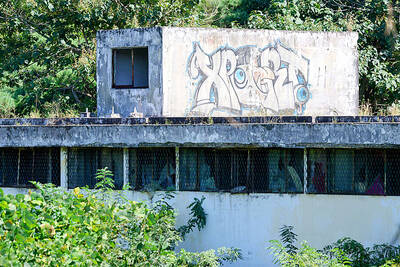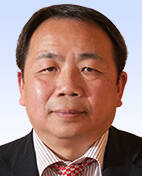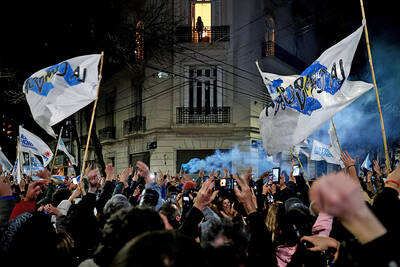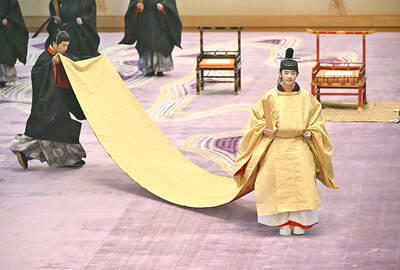When US Senator John Kerry received the endorsement last week of US Representative Jim Clyburn, South Carolina's only black congressman, he was anxious to portray his latest prominent supporter not just as an ally but a friend.
"I've gotten to know Jim over the last couple of years," said Kerry, the frontrunner for the Democratic presidential nomination.

PHOTO: AP
"I learned how to talk over the loud noise in the garage at a fish fry. And to dance a bit late at night, and have some mighty good fish."
Clyburn interjected with a playful putdown: "I wouldn't call that dancing."
Like half of a double act Kerry waited for the laughter to subside and responded: "I thought for a white guy I showed some rhythm."
Welcome to electioneering Southern style, where talk of what unites most Southerners -- food, religion, geography -- is evoked to mask the issue that divides them: race.
And in few places is this more true than in South Carolina, the first state to leave the union and help spark a civil war in the 19th century, and the last to keep the Confederate flag flying on the lawn of its capitol building, in Columbia.
In a primary where half the electorate is black, a candidate cannot avoid the issue.
In a state where Republicans use racism as a wedge to appeal to poor whites, it is the last thing Democrat candidates who want to get elected will talk about honestly.
Today's vote in South Carolina is one of seven across the country; there are also primaries in Arizona, Oklahoma, Missouri and Delaware and caucuses in New Mexico and North Dakota.
South Carolina may not send the most delegates to the national convention which will ultimately anoint the presidential nominee, but all the candidates acknowledge that the state has huge symbolic importance.
In the past week the candidates have weaved through black churches and white neighborhoods talking about healing the nation without ever addressing the gaping wound before them.
"They're not going to talk about it unless they absolutely have to," says Kymm Hunter, who works at Benedict College, a historically black college in Columbia.
"Racism's still strong here so they just won't tell it like it is."
Hunter is voting for the Reverend Al Sharpton, the only black in the race, who breaks the race taboo, sometimes with frustration but more often with humor.
"I'm the son of a man who couldn't be a mill worker because of the color of his skin," he told John Edwards, the North Carolina senator and Democratic hopeful who makes much of his humble upbringing, at a recent debate.
Two days later he said: "If he thinks it's a long distance from a mill house to the White House he should think about how far it is from the outhouse of the mill house to the White House."
If race describes a difference between the voters, economics and electability define the issues motivating them. Sharpton has coined the best lines of the campaign as he has been working through the churches and black colleges of South Carolina for several months.
But the latest Zogby tracking poll puts him fourth among black voters. The erratic polls nonetheless tell one essential story.
Whatever the differences between the South and the rest of the country and within the South itself, when it comes to this primary race Democrats share one overriding concern: they loathe US President George W. Bush with more intensity than they love any of the candidates.
"I connect with Al Sharpton on an emotional level," said Wayne Smith, a black Vietnam veteran.
"He's an important voice. But at the end of the day he's not going to make it happen. Senator Kerry has reached his stride. He can get rid of George Bush and that's what I want more than anything else."

LANDMARK CASE: ‘Every night we were dragged to US soldiers and sexually abused. Every week we were forced to undergo venereal disease tests,’ a victim said More than 100 South Korean women who were forced to work as prostitutes for US soldiers stationed in the country have filed a landmark lawsuit accusing Washington of abuse, their lawyers said yesterday. Historians and activists say tens of thousands of South Korean women worked for state-sanctioned brothels from the 1950s to 1980s, serving US troops stationed in country to protect the South from North Korea. In 2022, South Korea’s top court ruled that the government had illegally “established, managed and operated” such brothels for the US military, ordering it to pay about 120 plaintiffs compensation. Last week, 117 victims

China on Monday announced its first ever sanctions against an individual Japanese lawmaker, targeting China-born Hei Seki for “spreading fallacies” on issues such as Taiwan, Hong Kong and disputed islands, prompting a protest from Tokyo. Beijing has an ongoing spat with Tokyo over islands in the East China Sea claimed by both countries, and considers foreign criticism on sensitive political topics to be acts of interference. Seki, a naturalised Japanese citizen, “spread false information, colluded with Japanese anti-China forces, and wantonly attacked and smeared China”, foreign ministry spokesman Lin Jian told reporters on Monday. “For his own selfish interests, (Seki)

Argentine President Javier Milei on Sunday vowed to “accelerate” his libertarian reforms after a crushing defeat in Buenos Aires provincial elections. The 54-year-old economist has slashed public spending, dismissed tens of thousands of public employees and led a major deregulation drive since taking office in December 2023. He acknowledged his party’s “clear defeat” by the center-left Peronist movement in the elections to the legislature of Buenos Aires province, the country’s economic powerhouse. A deflated-sounding Milei admitted to unspecified “mistakes” which he vowed to “correct,” but said he would not be swayed “one millimeter” from his reform agenda. “We will deepen and accelerate it,” he

Japan yesterday heralded the coming-of-age of Japanese Prince Hisahito with an elaborate ceremony at the Imperial Palace, where a succession crisis is brewing. The nephew of Japanese Emperor Naruhito, Hisahito received a black silk-and-lacquer crown at the ceremony, which marks the beginning of his royal adult life. “Thank you very much for bestowing the crown today at the coming-of-age ceremony,” Hisahito said. “I will fulfill my duties, being aware of my responsibilities as an adult member of the imperial family.” Although the emperor has a daughter — Princess Aiko — the 23-year-old has been sidelined by the royal family’s male-only